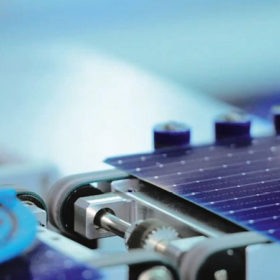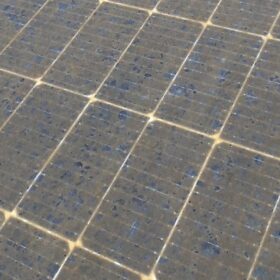U.S. researchers build 16%-efficient mini perovskite solar module resistant to UV light-induced degradation
A U.S. research team has built a 15 cm2 perovskite solar module with improved stability and efficiency thanks to a polymer hole transport layer that reportedly improves the panel stability and efficiency.
Chinese PV Industry Brief: JA Solar expects $110 million net loss for H1
JA Solar says it has incurred a $110 million net loss for the first half of 2024, due to rising competition in the solar market, continual price declines, lower gross profit from core operations, and significant provisions for inventory depreciation.
Using digital twin, roll-to-roll platform to design high-performance organic PV devices
An international team of researchers have demonstrated how to speed up the research and development of scalable, high-performing organic solar cells by using an automated, high-throughput platform. It relies on digital twin technology and roll-to-roll (R2R) printing in a closed-loop system.
Chinese PV Industry Brief: JinkoSolar’s TOPCon module shipments pass 100 GW
Chinese solar module maker JinkoSolar says it has shipped more than 100 GW of tunnel oxide passivated contact (TOPCon) modules in just 18 months.
New encapsulant for perovskite solar cells, modules withstands multiple accelerated ageing tests
Researchers in Italy have developed a low temperature a blanket-cover encapsulation technique that reportedly improves the stability of perovskite PV devices. They said the new technique reduces thermomechanical stresses caused by both the encapsulation process and the temperature gradients occurring during accelerated ageing stresses.
Optimizing electrically conductive adhesives for solar cell interconnections
German research institute ISC Konstanz has developed a new method to measure the contact resistance of solar cell interconnections made with electrically conductive adhesives (ECA). The proposed approach reportedly enables the precise characterization of both contact resistivity and bulk resistivity.
Chemitek offers metal oxides removal agent for PV panels
The Portugal-based company has developed a metal oxides removal agent product for PV installations located near foundries, steelworks and metal ore mines.
Google invests in Taiwanese solar developer New Green Power
Google has made a capital investment in Taiwan-based New Green Power, in a deal that grants the US company the rights to procure up to 300 MW of solar assets.
Yotta Energy launches ‘panel-level storage’ package for C&I solar
US storage and inverter specialist Yotta Energy says its new package has several advantages compared to conventional C&I solar storage solutions. For example, the design cuts out the need for a dedicated room or separate space for the battery racks and it reportedly keeps batteries cool, passively maintaining an ideal working temperature range, between 21 C and 38 C.
How to recycle methylammonium lead iodide from perovskite solar cells
A German research team has developed a new technique to recover and reuse methylammonium lead iodide (MAPbI3) from perovskite solar cells via solvent extraction. Such recycling method can reportedly save up to 61% costs in the lab and industrial manufacturing.










